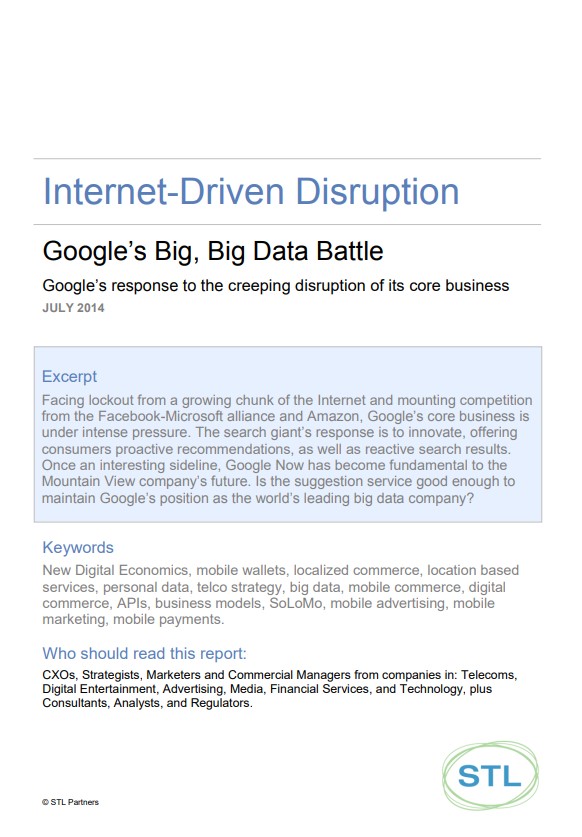Google’s Big, Big Data Battle
£1,000.00 excl VAT
Facing lockout from a growing chunk of the Internet and mounting competition from the Facebook-Microsoft alliance and Amazon, Google’s core business is under intense pressure. The search giant’s response is to innovate, offering consumers proactive recommendations, as well as reactive search results. Once an interesting sideline, Google Now has become fundamental to the Mountain View company’s future. Is the suggestion service good enough to maintain Google’s position as the world’s leading big data company?
Description
Format: PDF filePages: 48 pagesCharts: 27Author: STL research teamPublication Date: July 2014
Table of Contents
- Introduction
- Executive Summary
- The challenges to Google’s core business
- Google’s margin squeeze
- The rising importance of mobile apps
- Android forks
- Quality dilution
- Regulatory scrutiny
- Google’s strategy – get on the front foot
- Google Now – turning search on its head
- Reactive search becomes more proactive
- Voice input
- Anticipating wearables, connected cars and the Internet of Things
- Searching inside apps
- Evaluating Google Now
- The marketplace
- Develop compelling service offerings
- The value network
- Technology
- Finance – the high-level business model
Table of Figures
- Figure 1: How Google is neutralising threats and pursuing opportunities
- Figure 2: Google margins are steadily falling as volumes continue to rise
- Figure 3: Google’s operating mar gins are now below those of Apple and Facebook
- Figure 4: The cost per click is declining in lockstep with rising volume
- Figure 5: Rising distribution costs are driving Google’s TAC upwards
- Figure 6: Google’s revenues are increasingly coming from in-house sites and apps
- Figure 7: R&D is the fastest-growing ad-acquisition cost in absolute terms
- Figure 8: Daily active users of Facebook generating content out of Google’s reach
- Figure 9: Google is still the most popular destination on the Internet
- Figure 10: In the U.S., usage of desktop web sites is falling
- Figure 11: Google’s declining share of mobile search advertising in the U.S.
- Figure 12: Google’s lead on the mobile web is narrower than on the desktop web
- Figure 13: Top smartphone apps in the U.S. by average unique monthly users
- Figure 14: For Google, its removal from the default iOS Maps app is a major blow
- Figure 15: On Android, Google owns four of the five most used apps in the U.S.
- Figure 16: The resources Google needs to devote to web spam are rising over time
- Figure 17: Google, now genuinely global.
- Figure 18: A gap in the market: Timely proactive recommendations
- Figure 19: Google’s search engine is becoming proactive
- Figure 20: The ongoing evolution of Google Search into a proactive, recommendations service
- Figure 21: The Telco 2.0 Business Model Framework
- Figure 22: Amazon Local asks you to set preferences
- Figure 23: Google Now’s cards and the information they use
- Figure 24: Android dominates the global smartphone market
- Figure 25: Samsung has about 30% of the global smartphone market
- Figure 26: Google – not quite the complete Internet company
- Figure 27: Google’s strategic response
Technologies and industry terms referenced include: APIs, big data, business models, digital commerce, Disruption, facebook, google, Innovation, localized commerce, location based services, microsoft, mobile advertising, mobile commerce, mobile marketing, mobile payments, Mobile wallets, new digital economics, Personal Data, smartphone, SoLoMo, Strategies, Strategy, Telco 2.0, telco strategy


